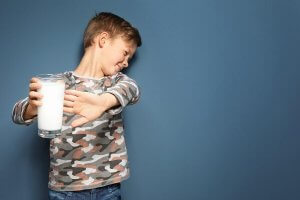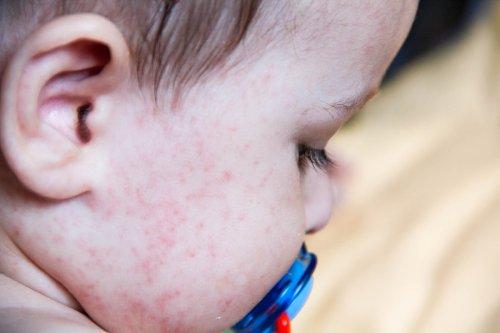Food Allergies in Children: What You Need to Know

A food allergy is how our immune system reacts to something specific we eat. The appearance of food allergies in children is three times more likely than in adults, due to their intolerance for many foods.
In small children, digestive discomfort and skin spots are the first manifestations of food allergy. You must be especially alert with babies since, in 50% of the cases, symptoms appear before three years of age.
The only treatment against food allergies is to stop consuming the food in question immediately, which gives the immune system time to evolve. Tolerance tests are usually scheduled at a hospital to find out if the allergen in question is accepted.
Food allergies in children
Food allergies in children come from ingesting different foods. You should know that any food can potentially induce allergy. In fact, there are more than 170 types of food that can cause allergic reactions, but only a minority of them are responsible for the reactions.
To treat children’s food intolerances, it’s necessary to know which foods cause them harm, the symptoms they produce and how to avoid them.
What foods cause food allergies in children?
The following are some of the main things that cause food allergies in children. It’s time to take note!
1.Eggs
Eggs are the leading cause of hospital visits due to food allergies in children. About 60% of children affected by egg allergy lose their allergies around three years of age.
2. Peanuts
Peanuts can trigger a strong allergic reaction due to the proteins present in the seeds. Peanut allergy in children ranks second in terms of frequency (behind egg whites).
3. Cow’s milk
Children who are allergic to cow’s milk are also allergic to goat’s milk. A good substitute for cow’s milk, after two years of age, is soy milk, as it’s rich in protein, calcium and vitamin D.
4. Walnuts
Nuts can be responsible for severe allergic reactions. If a child is allergic to nuts, you should pay particular attention to what they eat, since they’re ubiquitous in the food industry and it’s not easy to avoid them.
5. Wheat
Around 50% of children develop tolerance when they’re five years old while 75% acquire it when they’re eight years old.
6. Fish
The risk of contamination between crustaceans, mollusks, and fish is very significant. Therefore, it’s advisable to buy fish in hermetically sealed packages.
7. Kiwi
Kiwi is one of the fruits that produces the most food allergies to children. Allergic reactions to kiwi manifest with itching in the mouth, throat, and ears.
“The food you eat can be either the safest and most powerful form of medicine or the slowest form of poison.”
–Ann Wigmore–
What are the symptoms of food allergies in children?
The symptoms associated with food allergies in children can appear in minutes, hours or days after ingesting the food. These are the most prominent:
- Eczema, urticaria or swollen red spots.
- Difficulty sleeping and rapid changes in their overall state.
- Diarrhea and persistent constipation.
- Growth delays or low weight.
- Asthma, difficulty breathing, swollen lips, tongue, and throat.
- Crying and irritability.
What are the symptoms of a severe allergic reaction to food?
The following symptoms reveal that the child suffers a severe allergic reaction. In these cases, we advise that you visit the doctor as soon as possible.
- Vomiting.
- Drowsiness and loss of consciousness.
- Swollen lips and tongue.
- Respiratory problems.

How to combat food allergies in children
Finally, we’ll take a look at some of the suggestions that’ll allow you to deal with food allergies in children:
- Wash children’s hands before and after eating.
- Children must understand the risks of sharing food.
- If you go to a restaurant and your children have some type of allergy, you must communicate it.
- Work and food surfaces should be thoroughly cleaned to remove all residues of allergenic foods.
- If your children are allergic to a particular food, make sure to inform their care staff and plan a strategy to ensure their safety.
- Children with allergies can carry a card that mentions the type of allergy they have and the foods they should avoid.
- In schools, it’s important that they never share utensils or containers.
- Make sure your children always have an epinephrine auto-injector with them and know how to use it.
Ultimately, remember that it’s not possible to predict any severe allergic reaction. If your children are allergic to a certain food, it’s best if you inform everyone in their immediate environment so they know what to do in case of an emergency.
A food allergy is how our immune system reacts to something specific we eat. The appearance of food allergies in children is three times more likely than in adults, due to their intolerance for many foods.
In small children, digestive discomfort and skin spots are the first manifestations of food allergy. You must be especially alert with babies since, in 50% of the cases, symptoms appear before three years of age.
The only treatment against food allergies is to stop consuming the food in question immediately, which gives the immune system time to evolve. Tolerance tests are usually scheduled at a hospital to find out if the allergen in question is accepted.
Food allergies in children
Food allergies in children come from ingesting different foods. You should know that any food can potentially induce allergy. In fact, there are more than 170 types of food that can cause allergic reactions, but only a minority of them are responsible for the reactions.
To treat children’s food intolerances, it’s necessary to know which foods cause them harm, the symptoms they produce and how to avoid them.
What foods cause food allergies in children?
The following are some of the main things that cause food allergies in children. It’s time to take note!
1.Eggs
Eggs are the leading cause of hospital visits due to food allergies in children. About 60% of children affected by egg allergy lose their allergies around three years of age.
2. Peanuts
Peanuts can trigger a strong allergic reaction due to the proteins present in the seeds. Peanut allergy in children ranks second in terms of frequency (behind egg whites).
3. Cow’s milk
Children who are allergic to cow’s milk are also allergic to goat’s milk. A good substitute for cow’s milk, after two years of age, is soy milk, as it’s rich in protein, calcium and vitamin D.
4. Walnuts
Nuts can be responsible for severe allergic reactions. If a child is allergic to nuts, you should pay particular attention to what they eat, since they’re ubiquitous in the food industry and it’s not easy to avoid them.
5. Wheat
Around 50% of children develop tolerance when they’re five years old while 75% acquire it when they’re eight years old.
6. Fish
The risk of contamination between crustaceans, mollusks, and fish is very significant. Therefore, it’s advisable to buy fish in hermetically sealed packages.
7. Kiwi
Kiwi is one of the fruits that produces the most food allergies to children. Allergic reactions to kiwi manifest with itching in the mouth, throat, and ears.
“The food you eat can be either the safest and most powerful form of medicine or the slowest form of poison.”
–Ann Wigmore–
What are the symptoms of food allergies in children?
The symptoms associated with food allergies in children can appear in minutes, hours or days after ingesting the food. These are the most prominent:
- Eczema, urticaria or swollen red spots.
- Difficulty sleeping and rapid changes in their overall state.
- Diarrhea and persistent constipation.
- Growth delays or low weight.
- Asthma, difficulty breathing, swollen lips, tongue, and throat.
- Crying and irritability.
What are the symptoms of a severe allergic reaction to food?
The following symptoms reveal that the child suffers a severe allergic reaction. In these cases, we advise that you visit the doctor as soon as possible.
- Vomiting.
- Drowsiness and loss of consciousness.
- Swollen lips and tongue.
- Respiratory problems.

How to combat food allergies in children
Finally, we’ll take a look at some of the suggestions that’ll allow you to deal with food allergies in children:
- Wash children’s hands before and after eating.
- Children must understand the risks of sharing food.
- If you go to a restaurant and your children have some type of allergy, you must communicate it.
- Work and food surfaces should be thoroughly cleaned to remove all residues of allergenic foods.
- If your children are allergic to a particular food, make sure to inform their care staff and plan a strategy to ensure their safety.
- Children with allergies can carry a card that mentions the type of allergy they have and the foods they should avoid.
- In schools, it’s important that they never share utensils or containers.
- Make sure your children always have an epinephrine auto-injector with them and know how to use it.
Ultimately, remember that it’s not possible to predict any severe allergic reaction. If your children are allergic to a certain food, it’s best if you inform everyone in their immediate environment so they know what to do in case of an emergency.
All cited sources were thoroughly reviewed by our team to ensure their quality, reliability, currency, and validity. The bibliography of this article was considered reliable and of academic or scientific accuracy.
- TSabouri, S., Feketea, G. & Nicolaou, N. Food allergy in children. in Food Allergy: Methods of Detection and Clinical Studies (2017). doi:10.1201/9781315151786
- Christie, L., Hine, R. J., Parker, J. G. & Burks, W. Food allergies in children affect nutrient intake and growth. J. Am. Diet. Assoc. (2002). doi:10.1016/S0002-8223(02)90351-2
- Ho, M. H. K., Wong, W. H. S. & Chang, C. Clinical spectrum of food allergies: A comprehensive review. Clinical Reviews in Allergy and Immunology (2014). doi:10.1007/s12016-012-8339-6
This text is provided for informational purposes only and does not replace consultation with a professional. If in doubt, consult your specialist.








